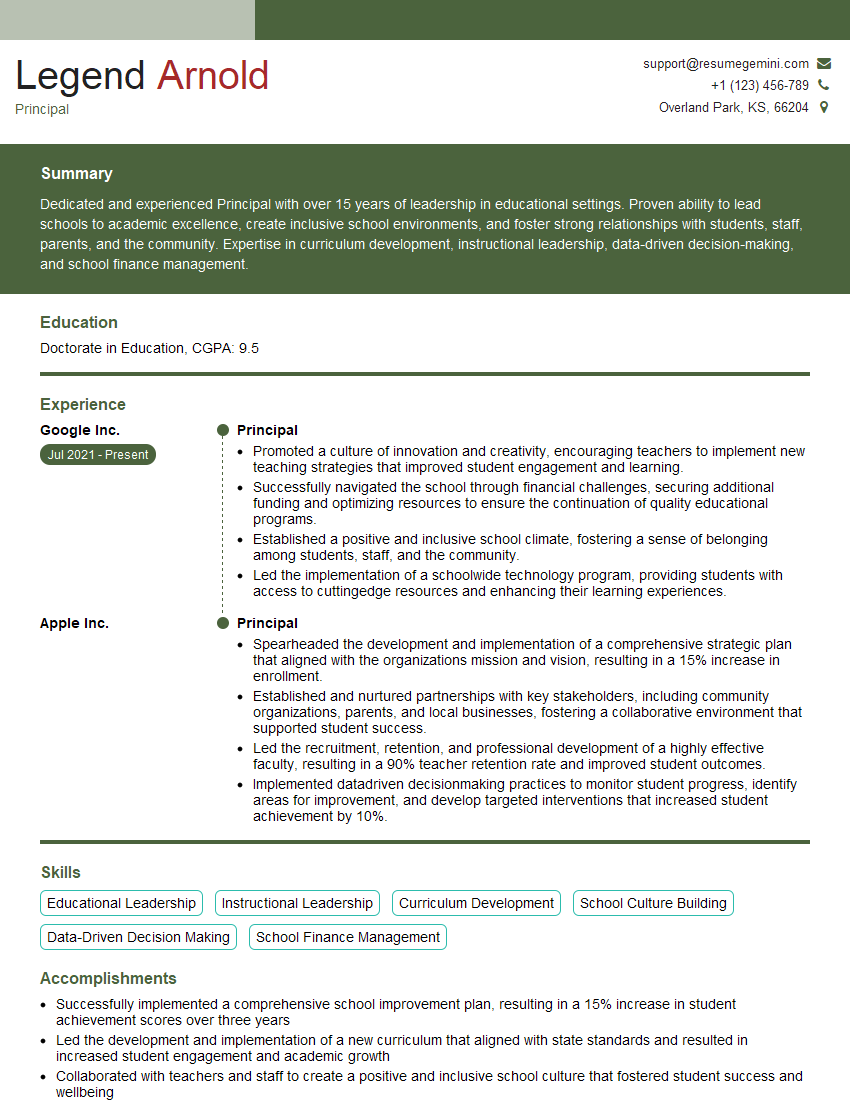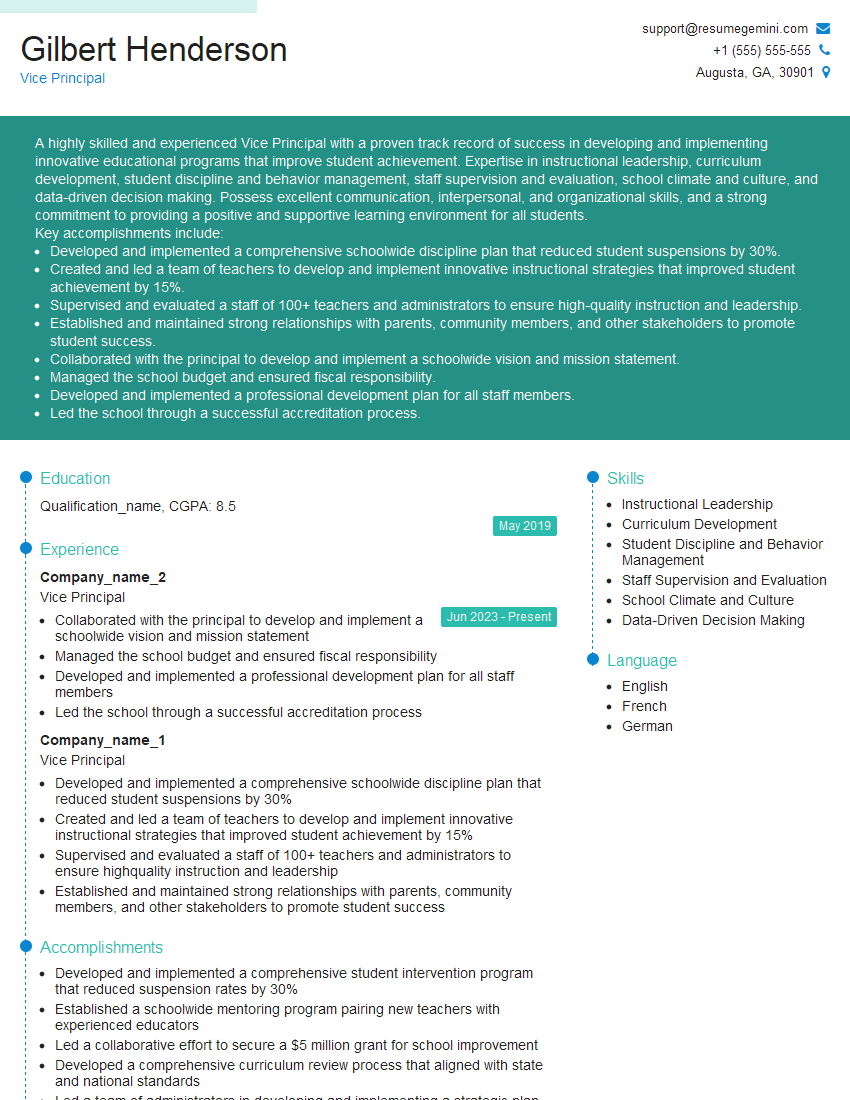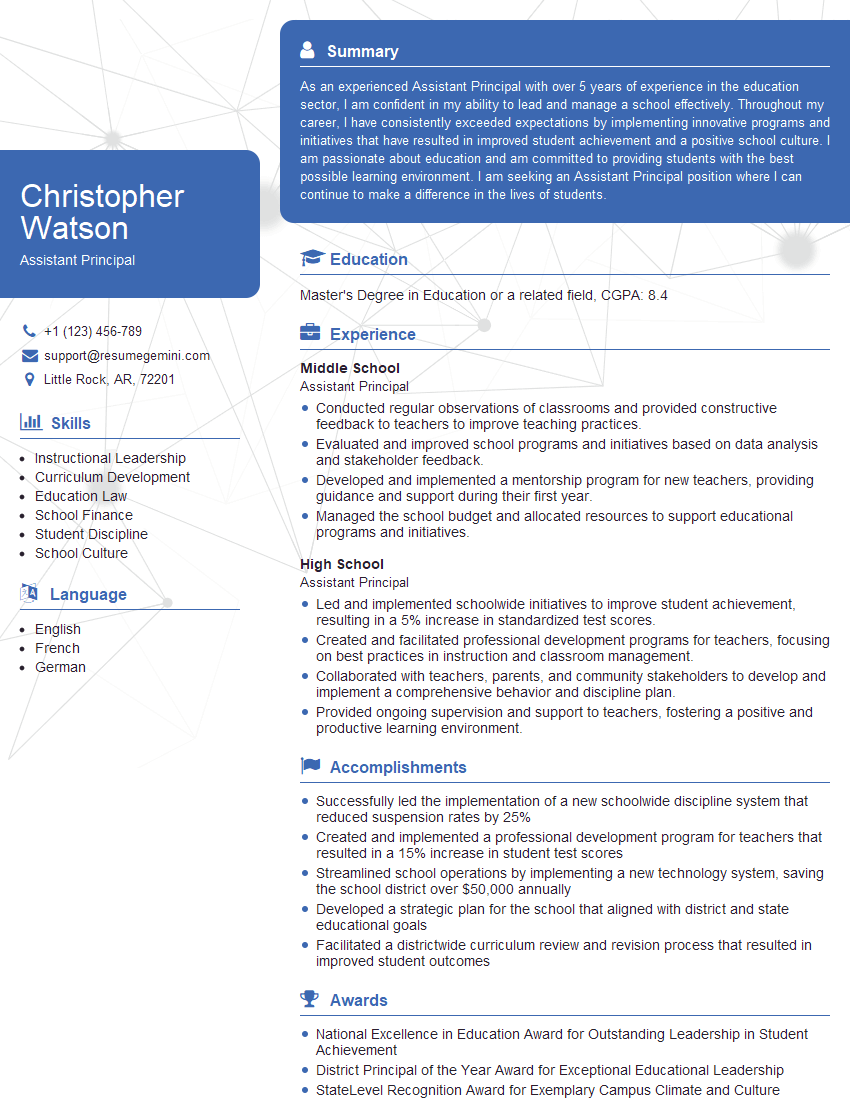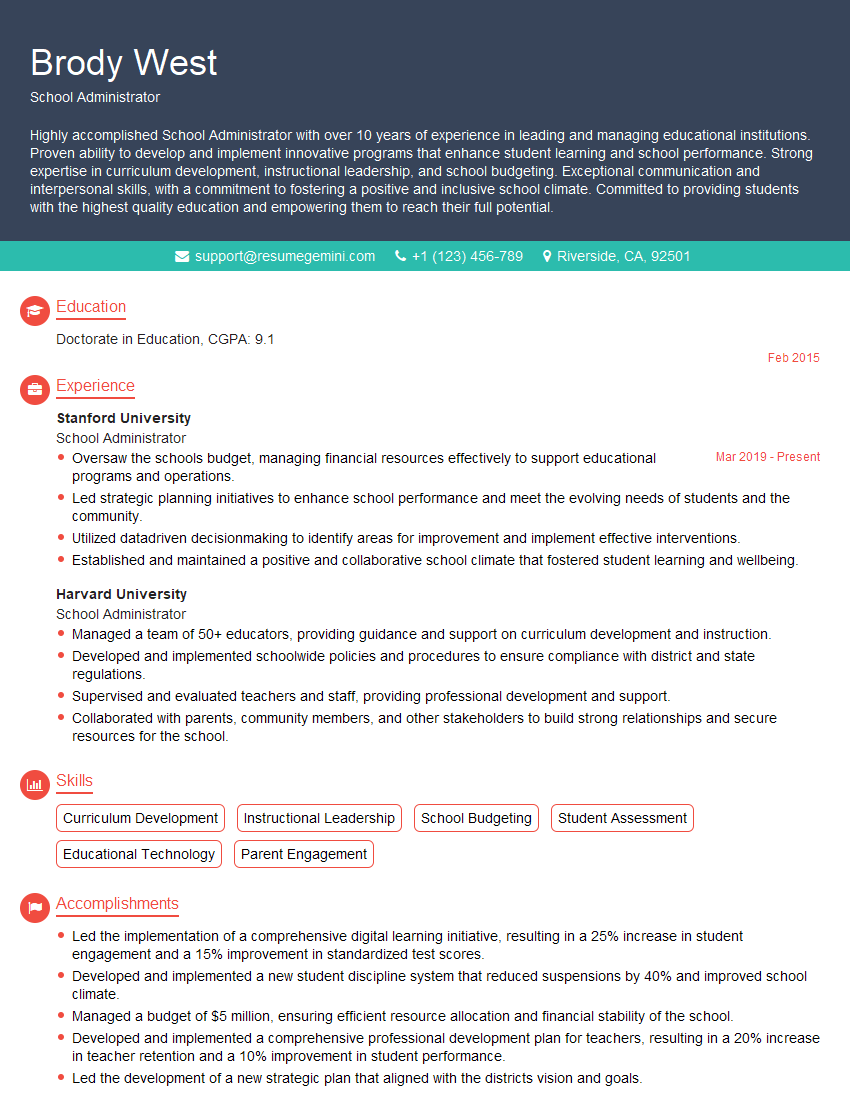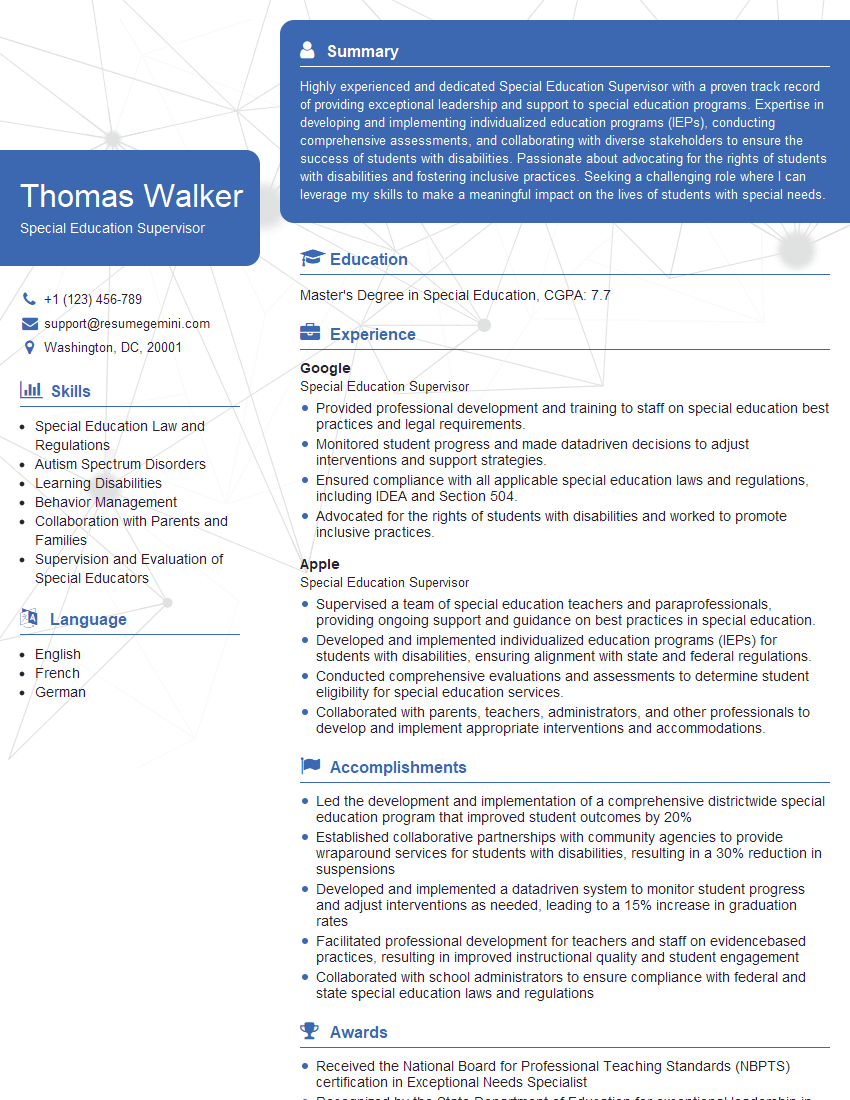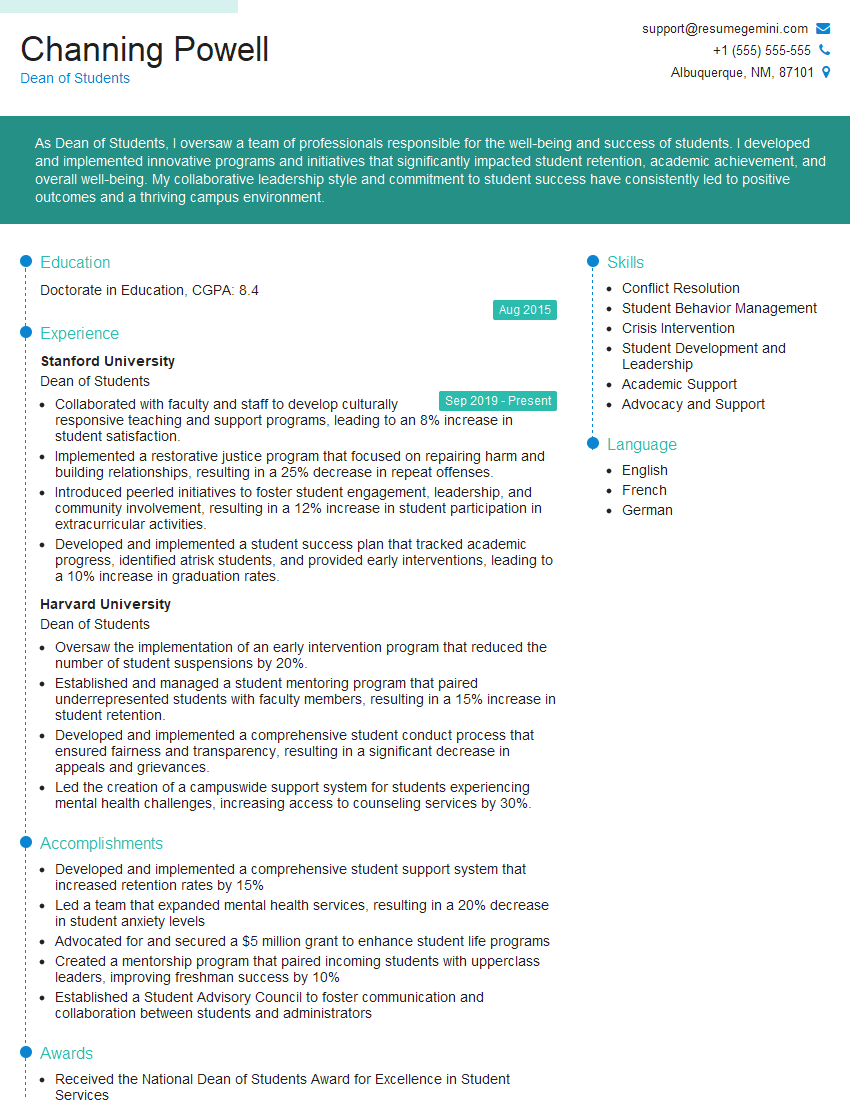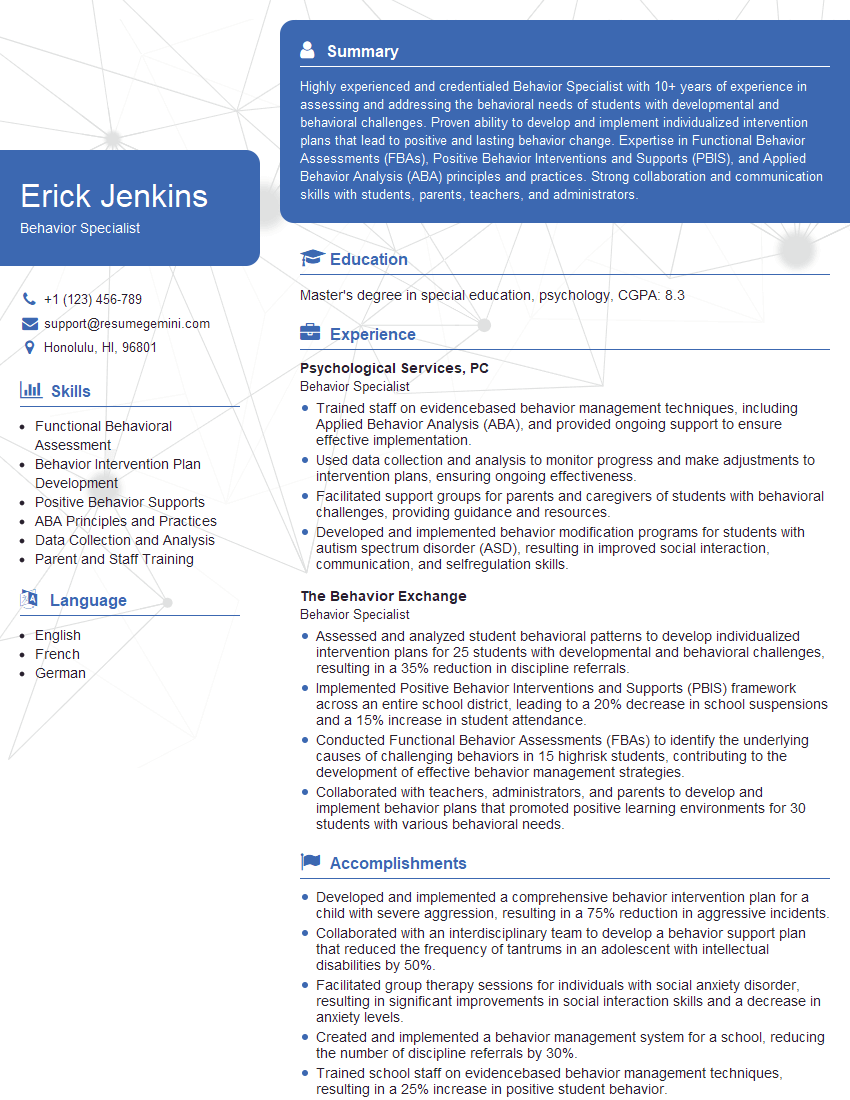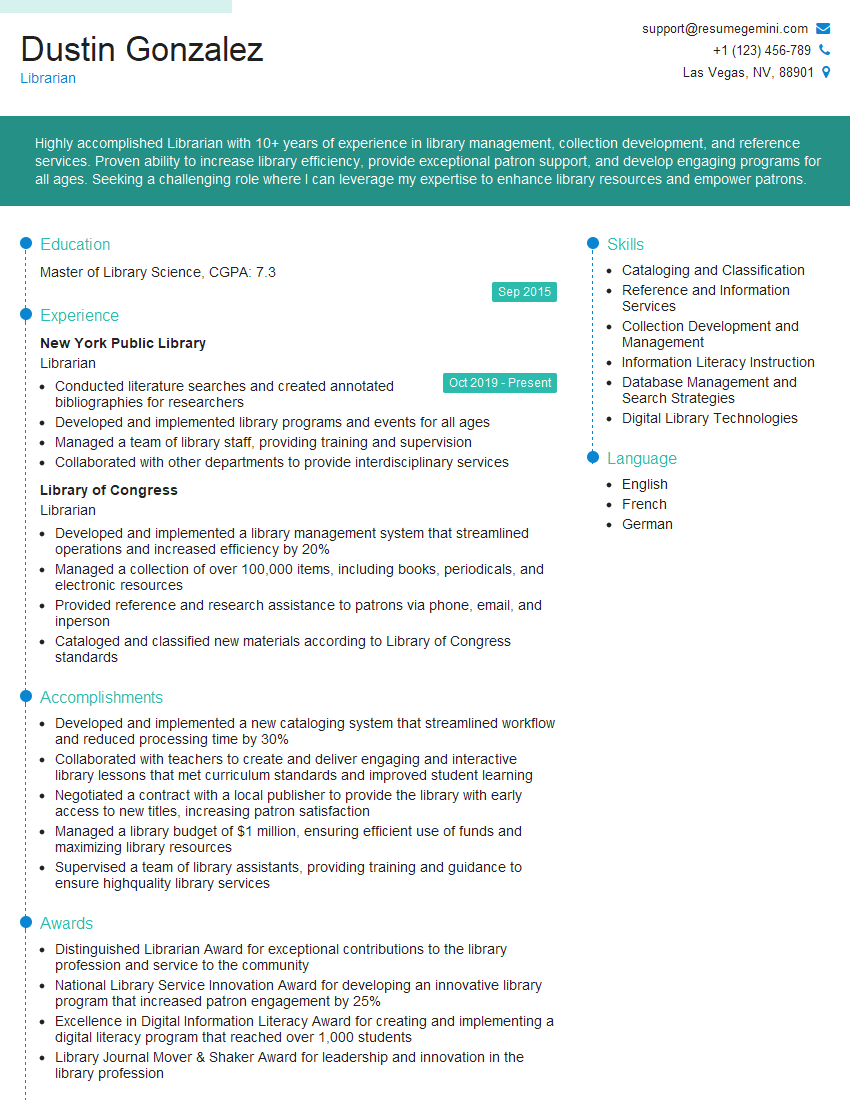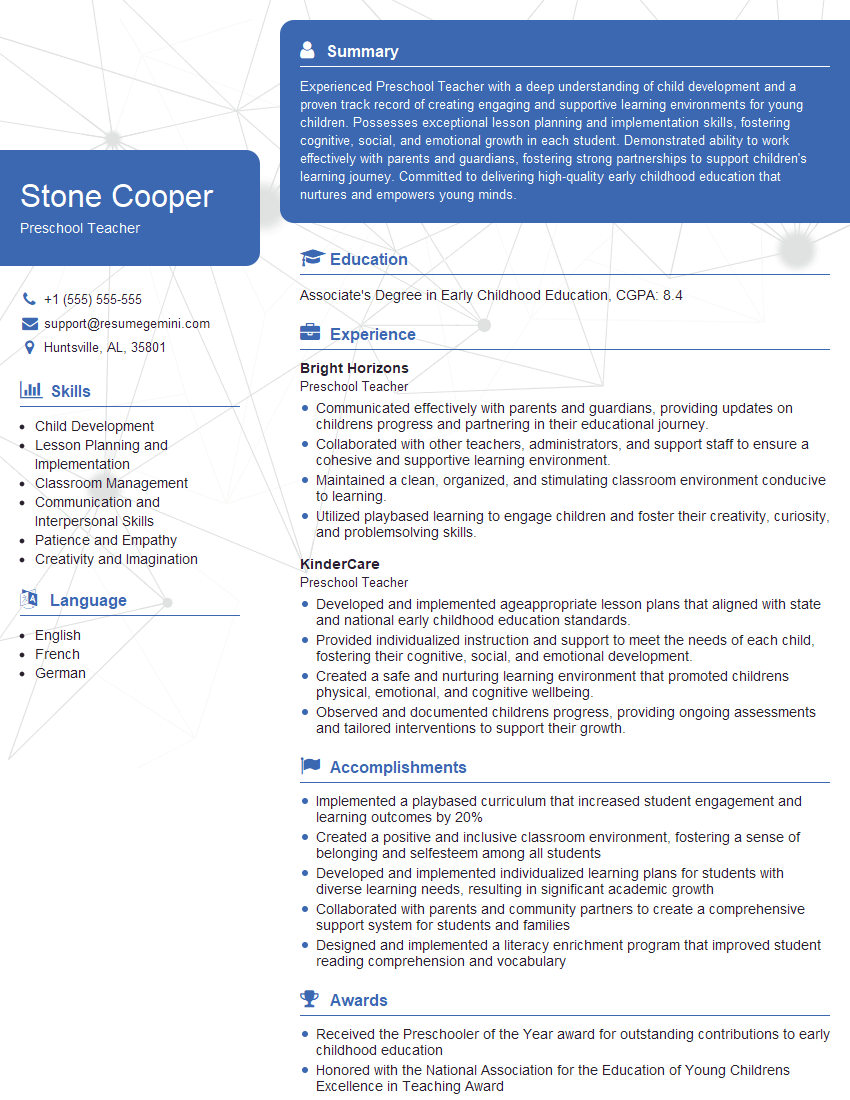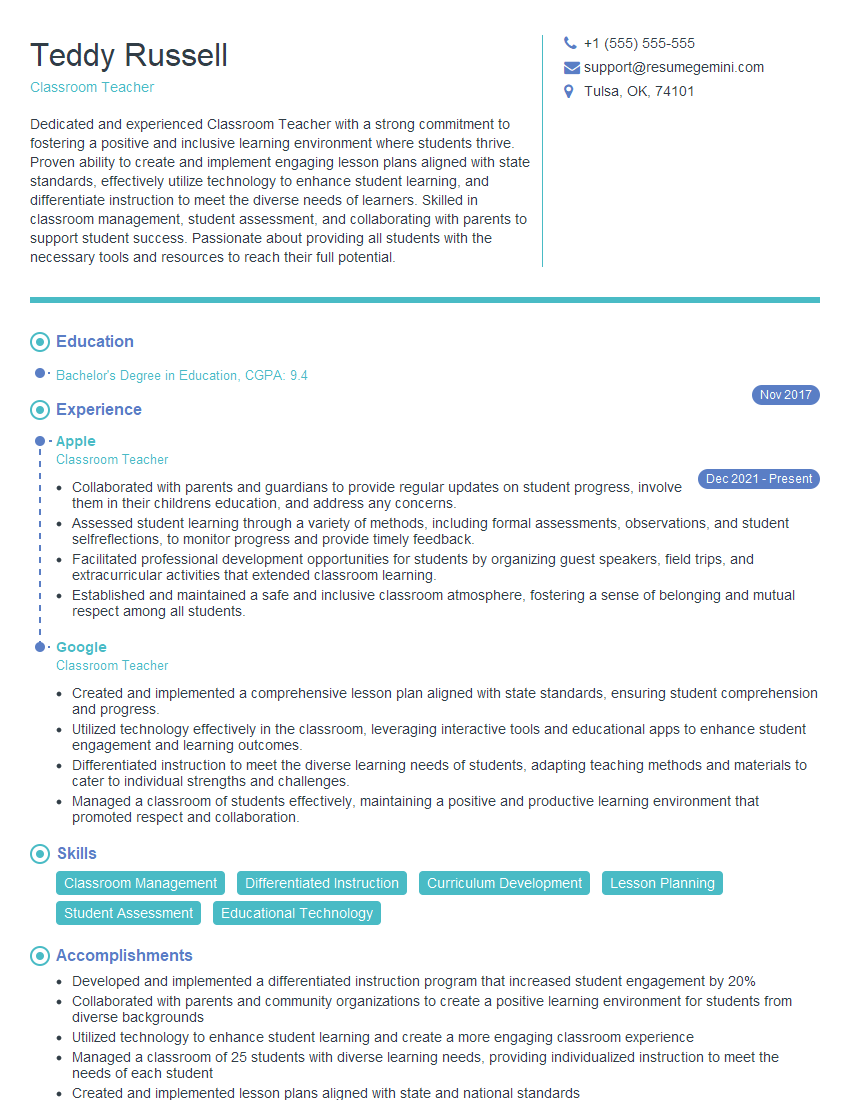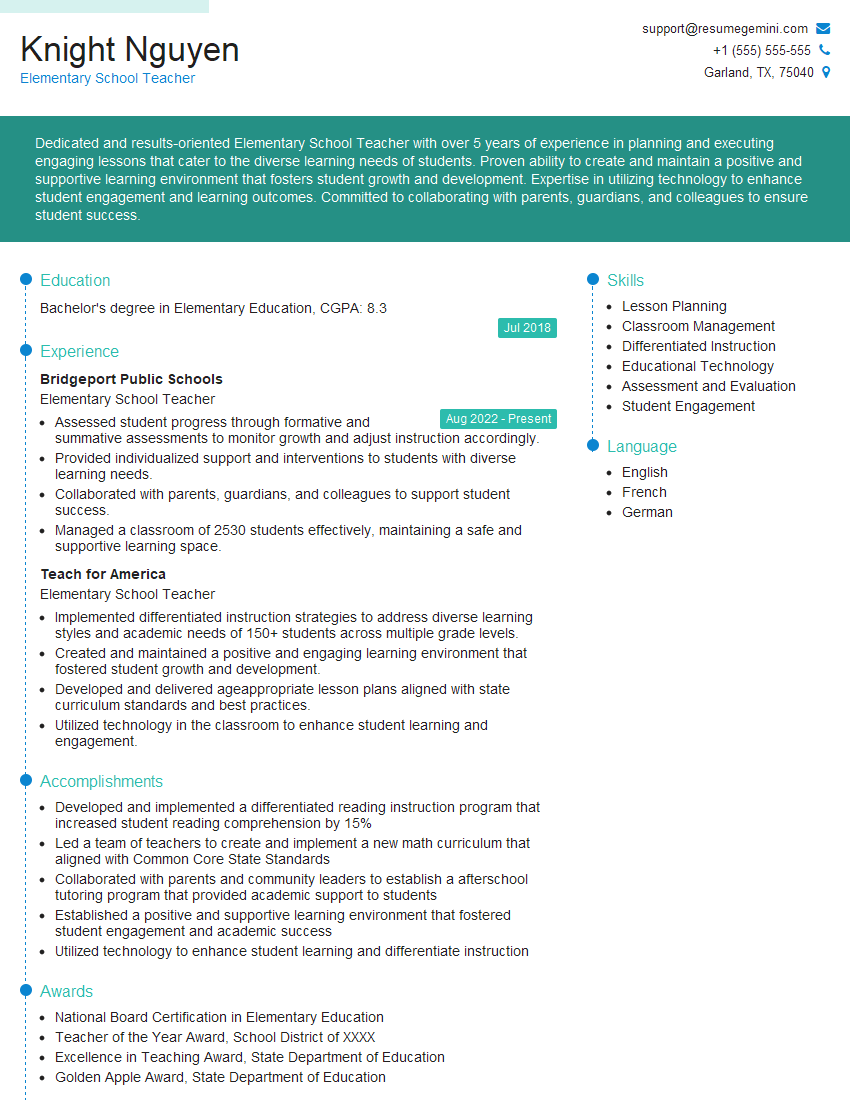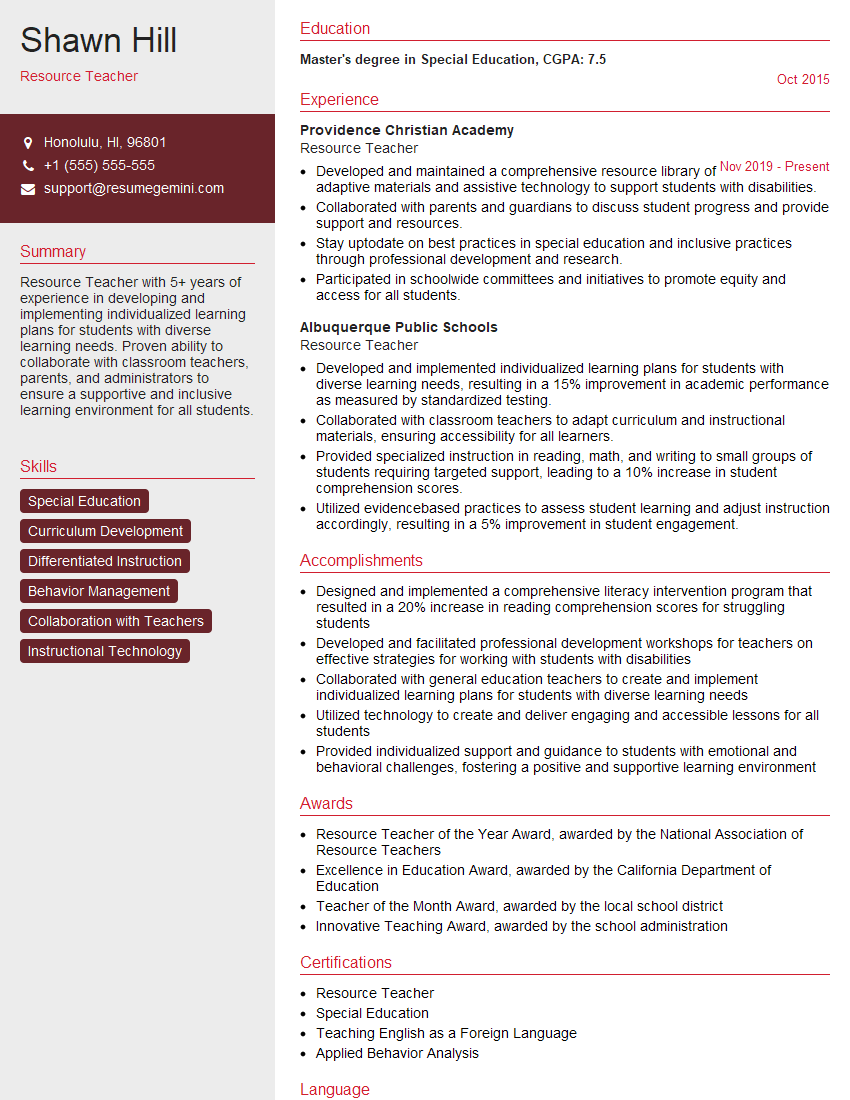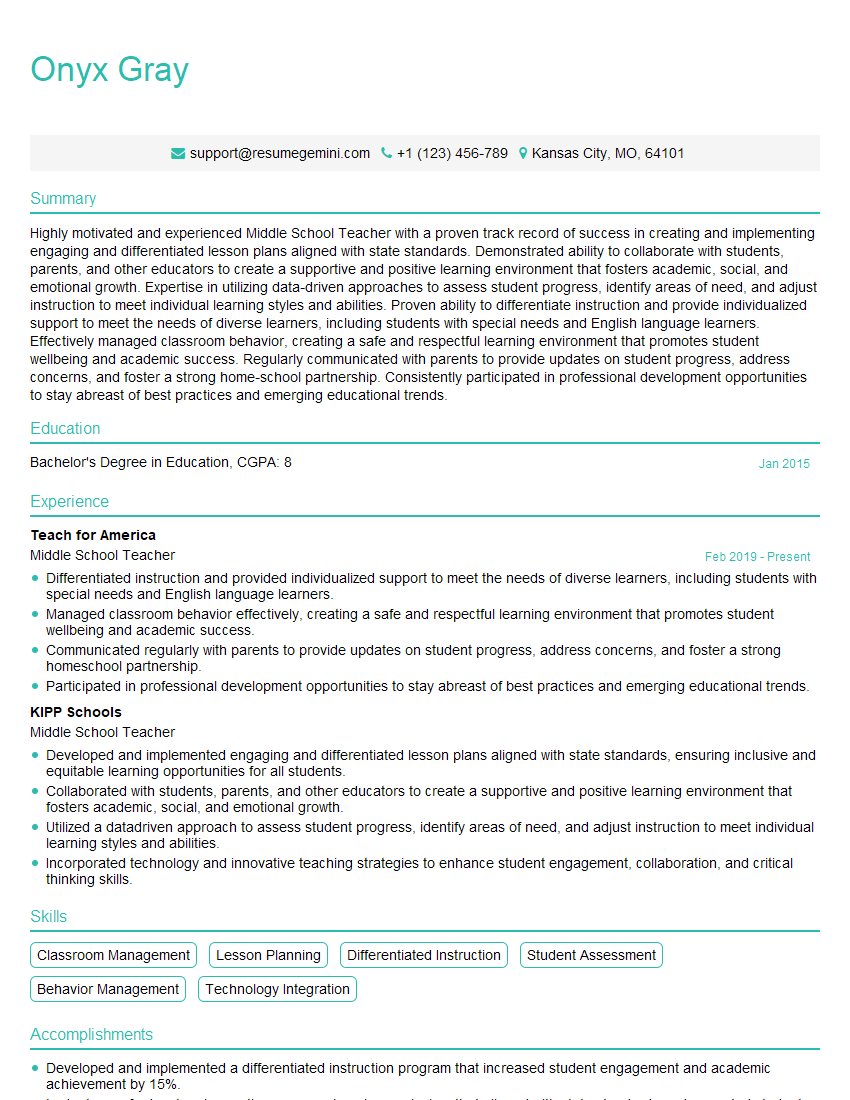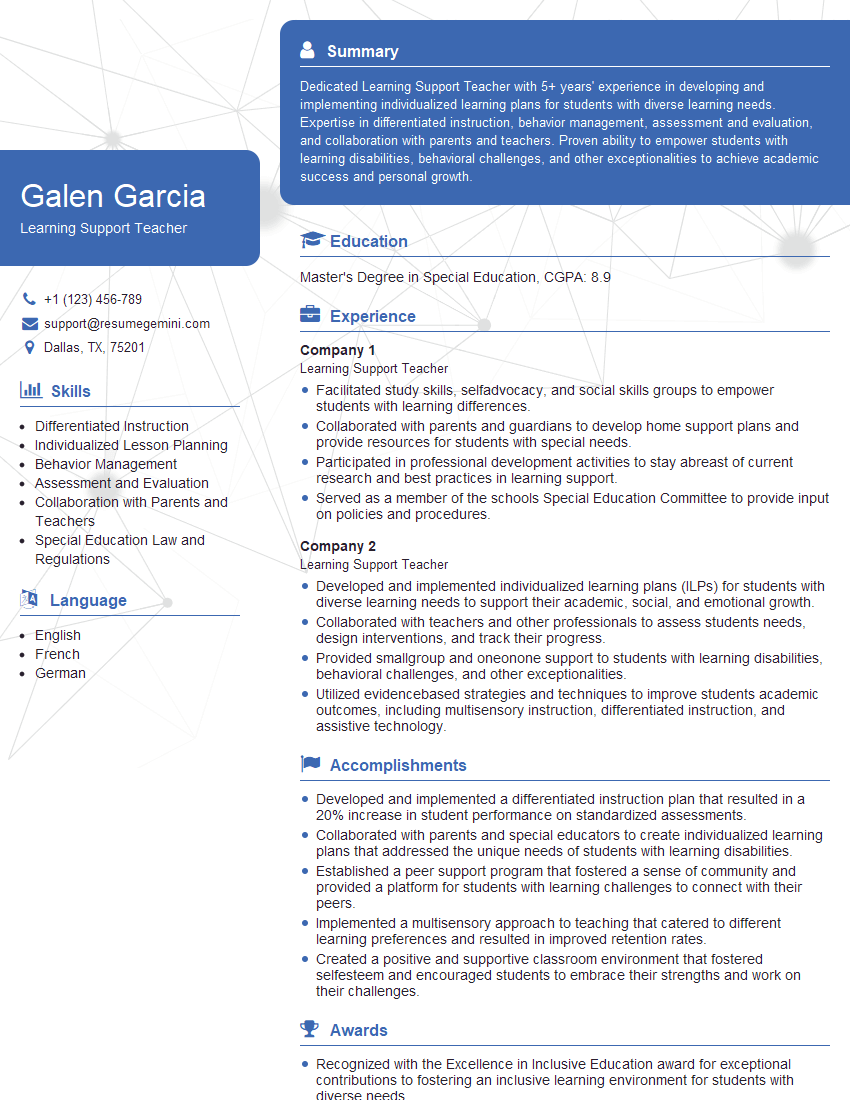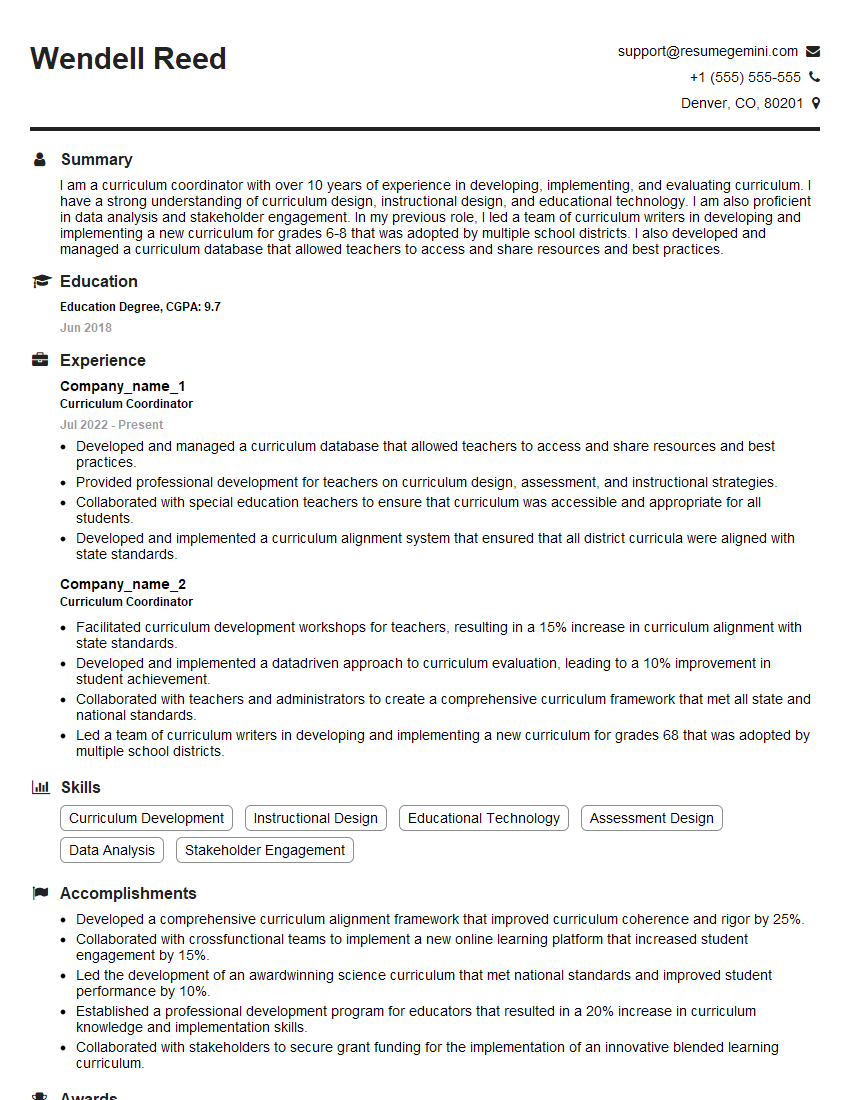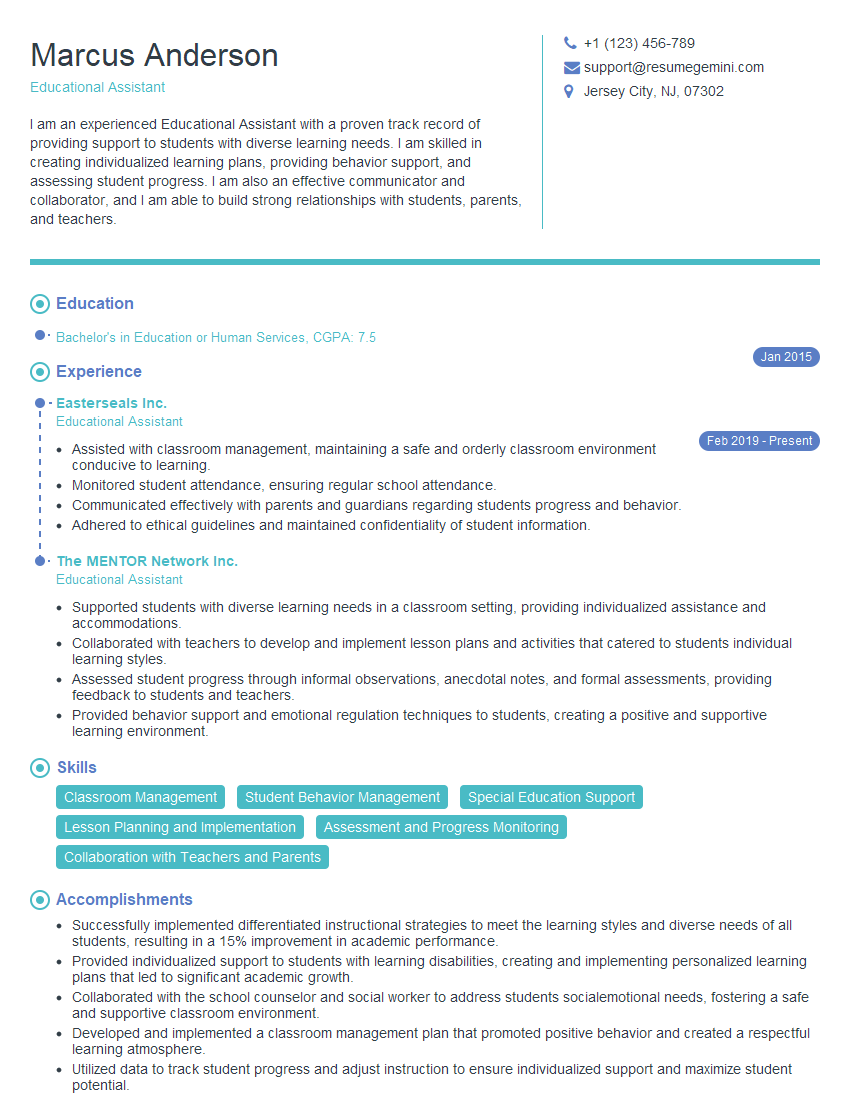Interviews are opportunities to demonstrate your expertise, and this guide is here to help you shine. Explore the essential Classroom Organization interview questions that employers frequently ask, paired with strategies for crafting responses that set you apart from the competition.
Questions Asked in Classroom Organization Interview
Q 1. Describe your preferred classroom layout and why it’s effective.
My preferred classroom layout is a flexible blend of individual, group, and whole-class learning spaces. Instead of rigidly fixed desks, I utilize a combination of small group tables, individual workspaces (possibly carrels or designated areas), and a designated area for whole-class instruction (perhaps a rug or flexible seating arrangement near the board). This approach caters to diverse learning styles and activity types.
Why it’s effective: This flexible arrangement allows me to easily transition between different teaching methods. For example, collaborative group work thrives at the tables, independent study happens in the individual workspaces, and whole-class discussions or direct instruction are facilitated in the designated area. It promotes both independent learning and social interaction. The fluidity also allows for easy adjustments depending on the lesson; a particularly engaging project might necessitate rearranging the tables into a larger collaborative space.
For instance, during a collaborative science project, students work effectively at the group tables. Later in the day, when focusing on individual reading comprehension, they transition smoothly to their individual workspaces. This flexibility reduces classroom disruption and maximizes learning time.
Q 2. How do you manage classroom materials and resources efficiently?
Efficient management of classroom materials and resources is crucial. I utilize a multi-pronged approach: clearly labeled storage containers for each subject, a central supply area readily accessible to students, and a dedicated space for projects in progress. Regular purging of outdated materials is key.
Specifically, I use color-coded bins for different subjects (e.g., red for math, blue for reading). Each bin is clearly labeled with both text and pictures (for younger students). This visual organization helps students locate needed supplies quickly and independently, fostering self-reliance and minimizing classroom disruptions.
Furthermore, I involve students in organizing and maintaining the classroom. Assigned classroom helpers rotate weekly, taking responsibility for specific tasks like tidying supplies or preparing materials for the next lesson. This instills a sense of ownership and responsibility.
Q 3. What strategies do you use to establish and maintain a positive classroom environment?
Establishing and maintaining a positive classroom environment is paramount. I achieve this through consistent application of positive reinforcement, clear expectations, and building strong student-teacher relationships.
Strategies:
- Positive Reinforcement: I focus on praising effort and progress rather than solely on grades. Verbal praise, small rewards (like classroom privileges), and positive notes home all contribute to building a positive atmosphere. I also publicly acknowledge students’ achievements to encourage their peers.
- Clear Expectations: Classroom rules and expectations are co-created with the students whenever possible. This involves discussions about appropriate behavior and consequences for misbehavior. Consistency in enforcing these rules is crucial.
- Building Relationships: I make an effort to learn about each student’s individual interests and needs. Regular one-on-one check-ins and informal conversations create a safe and supportive classroom culture. I also actively foster a culture of respect and empathy amongst students.
For example, instead of saying “Stop talking!” I might say, “I appreciate you’re excited about the project, but let’s make sure everyone can hear the instructions.” This approach redirects behavior constructively and maintains a positive tone.
Q 4. Explain your approach to creating a visually organized classroom.
A visually organized classroom minimizes distractions and enhances learning. Key elements include clearly labeled areas, thematic displays, and the strategic use of color and space.
I organize my classroom by using color-coded learning centers for different subject areas. I ensure that important information (like the daily schedule, class rules, or learning objectives) is prominently displayed in an easy-to-read format. Relevant posters or student work are used to decorate the walls, creating a stimulating and engaging learning environment.
For younger students, I incorporate more bright colors and simpler visuals. For older students, I use a more subtle color scheme and incorporate relevant imagery related to the current unit of study. This caters to the developmental needs and preferences of different age groups.
Q 5. How do you differentiate instruction to meet the diverse needs of learners in a structured environment?
Differentiation is key to meeting diverse learning needs within a structured environment. My approach involves adjusting instruction based on readiness, interest, and learning profile.
Strategies:
- Tiered Assignments: I offer assignments at varying levels of complexity, allowing students to choose the level that best suits their abilities. This ensures that all students are challenged appropriately.
- Flexible Grouping: Students are grouped based on their learning needs for specific activities. This might involve homogeneous grouping (students with similar needs) for focused instruction or heterogeneous grouping (students with diverse abilities) for collaborative tasks.
- Varied Instructional Methods: I use a variety of teaching methods – lectures, discussions, group work, hands-on activities – to cater to different learning styles. This ensures that students receive information in a way that resonates with them.
- Assistive Technology: Where necessary, I incorporate assistive technology to support students with specific learning challenges.
For instance, in a math lesson, I might provide different levels of support for solving word problems. Some students might need a visual representation, while others may require more direct instruction.
Q 6. How do you use technology to enhance classroom organization?
Technology plays a significant role in enhancing classroom organization. I utilize various tools for managing assignments, communication, and student progress tracking.
Examples:
- Learning Management Systems (LMS): Platforms like Google Classroom or Canvas are used to distribute assignments, collect work, and provide feedback. This centralizes communication and simplifies the management of student work.
- Classroom Response Systems: Tools like Kahoot! or Quizizz can be used for interactive quizzes and assessments, providing immediate feedback and engaging students actively.
- Educational Apps: Subject-specific apps can provide additional support and practice opportunities for students.
- Digital Calendars and Planners: Shared digital calendars help maintain a consistent schedule and facilitate effective time management for both myself and the students.
For example, using Google Classroom allows me to provide timely feedback on student work, share resources, and communicate announcements easily with parents and students. This digital organization streamlines communication and reduces administrative workload.
Q 7. Describe your system for tracking student progress and assignments.
Tracking student progress and assignments is crucial for effective teaching. I utilize a combination of digital and analog methods for comprehensive monitoring.
System:
- Digital Gradebook: I maintain a digital gradebook (typically within the LMS) to track grades and assignment completion. This allows for easy access to up-to-date information on each student’s progress.
- Student Portfolios: I encourage students to keep digital or physical portfolios that showcase their work over time. This allows them to track their own growth and provides a more holistic view of their progress than grades alone.
- Checklists and Planners: Both physical and digital checklists help me track assignments and deadlines effectively. I also regularly review student work to monitor their understanding and identify any areas needing additional support.
- Parent-Teacher Communication: Regular communication with parents through email, newsletters, or parent-teacher conferences is essential for ensuring a shared understanding of student progress and needs.
For instance, by reviewing student work samples regularly, I can identify patterns in student understanding and adjust my instruction accordingly. This ensures that I am meeting the needs of all learners in my classroom.
Q 8. How do you manage student behavior effectively without disrupting learning?
Effective classroom management hinges on proactive strategies that prevent disruptive behaviors rather than simply reacting to them. I believe in building positive relationships with students, establishing clear expectations, and consistently reinforcing positive behaviors. This approach creates a predictable and supportive learning environment where students feel safe and respected.
Positive Reinforcement: I use a system of rewards and recognition to encourage positive behaviors. This could be verbal praise, awarding class points, or even small privileges. For instance, if students are consistently following classroom rules, they might earn extra recess time or a class movie day.
Clear Expectations: I clearly communicate classroom rules and expectations from the start of the year, ensuring students understand the consequences of breaking those rules. These rules are collaboratively created whenever possible, giving students a sense of ownership and responsibility.
Non-Verbal Cues: Before resorting to verbal corrections, I often use non-verbal cues, such as proximity control (moving closer to a student who is distracting others), eye contact, or a gentle hand gesture to redirect behavior. This minimizes disruption to the lesson.
Individualized Approaches: I recognize that students have different needs and motivations. I take the time to understand individual student behavior patterns and adjust my strategies accordingly. Sometimes, a student’s disruptive behavior stems from unmet needs or learning difficulties, requiring a more personalized approach.
Q 9. What strategies do you employ for effective time management in the classroom?
Effective time management in the classroom is crucial for maximizing learning opportunities. My approach combines careful planning, efficient routines, and flexible strategies to adapt to unexpected events.
Detailed Lesson Plans: I develop detailed lesson plans that allocate specific time slots for each activity, ensuring that the lesson flows smoothly. I build in time for transitions between activities and anticipate potential delays.
Clear Transitions: I use clear signals and routines for transitions between activities. For example, a specific chime or a visual cue could signal the end of an independent work period and the start of a group activity. This minimizes wasted time and confusion.
Engaging Activities: I select engaging and appropriately challenging activities to keep students focused and motivated. Variety in teaching methods prevents boredom and maintains student attention.
Student Involvement: I involve students in time management by assigning roles or responsibilities, such as timekeepers, to monitor progress and ensure tasks are completed within allocated timeframes.
Flexibility: I acknowledge that unexpected events can occur. I build flexibility into my schedule, allowing for adjustments if needed. It’s important to remain adaptable and adjust to changing circumstances.
Q 10. How do you create a system for efficient communication with parents?
Maintaining open and effective communication with parents is vital for student success. I use a multi-faceted approach to ensure parents are informed and involved.
Regular Newsletters/Emails: I send out regular newsletters or emails to keep parents informed about upcoming events, important deadlines, and classroom activities. I also include positive news about student achievements and classroom highlights.
Parent-Teacher Conferences: I hold regular parent-teacher conferences, both scheduled and impromptu, to discuss individual student progress and address any concerns.
Online Communication Platforms: I utilize online platforms like ClassDojo or Seesaw to share updates, assignments, and announcements with parents in real-time. This allows for immediate communication and facilitates easy access to information.
Phone Calls/Emails: I proactively make phone calls or send emails to parents when I observe significant changes in a student’s behavior or academic performance, ensuring early intervention.
Parent Volunteers: Encouraging parent volunteers in the classroom fosters a strong home-school connection and strengthens communication.
Q 11. Describe your approach to organizing and grading student work.
Organizing and grading student work efficiently requires a systematic approach to ensure fairness and accuracy. I employ a combination of digital and physical organization methods.
Designated Submission Areas: I establish clear designated areas for students to submit their work, whether it’s a physical bin or an online platform. This reduces chaos and ensures assignments are easily collected.
Clear Grading Rubrics: I provide clear grading rubrics for each assignment, ensuring students understand the assessment criteria and expectations. Rubrics are shared both in print and digitally.
Digital Organization: I use digital platforms such as Google Classroom to collect and organize student work. This allows for easy access, feedback, and tracking of student progress.
Organized Physical Storage: For physical assignments, I use folders or binders to organize work by student and assignment. Each student might have a designated folder or section in my filing system.
Regular Grading Schedule: I establish a regular grading schedule to prevent an overwhelming backlog. This allows for timely feedback and helps students track their progress.
Q 12. How do you adapt your classroom organization for students with diverse learning needs?
Adapting classroom organization for students with diverse learning needs is a critical aspect of inclusive education. I use a differentiated instruction approach, tailoring my teaching methods and classroom environment to meet individual student needs.
Individualized Learning Plans (ILPs): I work closely with special education staff and parents to develop individualized learning plans for students with IEPs or 504 plans. These plans outline specific accommodations and modifications needed to ensure success.
Flexible Seating Arrangements: I provide a range of seating options, allowing students to choose the environment that best supports their learning style. This might include desks, tables, beanbag chairs, or standing desks.
Assistive Technology: I incorporate assistive technology such as text-to-speech software, graphic organizers, or adaptive learning platforms to support students with specific learning challenges.
Differentiated Instruction: I differentiate instruction by providing varied learning materials and activities. This may include different levels of reading materials, varied assignments, and flexible pacing.
Collaboration with Support Staff: I collaborate with special education teachers, counselors, and other support staff to ensure all students receive the appropriate support and services.
Q 13. What are your strategies for creating a safe and inclusive classroom environment?
Creating a safe and inclusive classroom environment is paramount. It’s a place where all students feel respected, valued, and empowered to learn. My approach involves fostering a sense of community and establishing clear expectations for respectful behavior.
Establishing Classroom Norms: We collaboratively create classroom norms, emphasizing respect, kindness, and inclusivity. These norms are displayed prominently and revisited regularly.
Conflict Resolution Strategies: I teach students effective conflict resolution strategies, emphasizing empathy and problem-solving. This might involve role-playing or discussion of real-life scenarios.
Celebrating Diversity: I create opportunities to celebrate the diversity of our classroom, acknowledging and respecting differences in culture, background, and ability. This might involve sharing stories, learning about different cultures, or creating inclusive projects.
Building Relationships: I invest time in building positive relationships with each student, creating a safe and supportive learning environment where they feel comfortable seeking help or sharing their thoughts and feelings.
Anti-Bullying Policies: I rigorously enforce anti-bullying policies, ensuring that all instances of bullying are addressed promptly and effectively. This includes creating a system for reporting and addressing bullying incidents.
Q 14. Explain your approach to preparing and maintaining classroom learning centers.
Learning centers are an invaluable tool for differentiated instruction and student engagement. My approach focuses on creating well-organized, engaging, and easily accessible centers.
Clear Purpose and Objectives: Each learning center has a clear purpose and specific learning objectives. These objectives align with the overall curriculum and are clearly communicated to students.
Variety of Activities: I offer a variety of activities within each center to cater to different learning styles and interests. This might include hands-on activities, technology-based activities, and independent reading.
Well-Organized Materials: All materials are clearly labeled and organized to ensure easy access and efficient use of time. Storage solutions are implemented to maintain a tidy learning environment.
Rotation Schedule: I use a rotation schedule to ensure all students have access to each learning center throughout the week. The rotation schedule is flexible and can be adjusted based on student needs.
Student Involvement: I involve students in maintaining and organizing the learning centers, fostering a sense of ownership and responsibility.
Q 15. How do you handle unexpected classroom disruptions effectively?
Unexpected disruptions are inevitable in a classroom. My approach focuses on proactive prevention and reactive strategies. Prevention involves establishing clear expectations and routines from day one, fostering a positive classroom culture, and building strong relationships with students. When disruptions occur, I use a tiered intervention system. A minor disruption, like a whispered conversation, might be addressed with a non-verbal cue or a gentle reminder. More significant disruptions, such as defiance or aggressive behavior, require a more structured response, potentially involving a brief, private conversation, a call to parents, or referral to school administration, depending on the severity and frequency. The key is to remain calm, consistent, and fair, always focusing on redirecting behavior rather than punishing the student. For example, if a student is disrupting the class by constantly getting out of their seat, I might involve them in a classroom helper role to channel their energy constructively. This approach acknowledges their need for movement while contributing to the class’s overall functioning.
Career Expert Tips:
- Ace those interviews! Prepare effectively by reviewing the Top 50 Most Common Interview Questions on ResumeGemini.
- Navigate your job search with confidence! Explore a wide range of Career Tips on ResumeGemini. Learn about common challenges and recommendations to overcome them.
- Craft the perfect resume! Master the Art of Resume Writing with ResumeGemini’s guide. Showcase your unique qualifications and achievements effectively.
- Don’t miss out on holiday savings! Build your dream resume with ResumeGemini’s ATS optimized templates.
Q 16. Describe your system for managing classroom supplies and equipment.
My system for managing classroom supplies and equipment is a blend of organization and student involvement. I utilize clearly labeled storage containers, shelves, and drawers, categorized by subject and frequency of use. A visual inventory system, possibly a checklist or a chart, helps me track supplies and identify shortages promptly. Importantly, students participate in maintaining the organization. Designated students might be responsible for distributing and collecting materials, restocking supplies, or ensuring equipment is put away properly. This system promotes responsibility and ownership while enhancing efficiency. For example, I have a designated ‘materials manager’ for each learning center who is responsible for the upkeep and organization of that specific area, which promotes student responsibility and collaboration.
Q 17. How do you organize and implement classroom routines and procedures?
Classroom routines and procedures are the backbone of an organized classroom. I introduce them explicitly at the start of the year, using visual aids like posters or anchor charts. Routines cover everything from entering and exiting the classroom, to transitions between activities, to submitting assignments. Procedures outline steps for specific tasks, such as using classroom technology or accessing learning materials. I model each routine and procedure explicitly several times before expecting students to follow them independently. Consistent reinforcement and positive feedback are essential. For example, a routine for handing in assignments could involve a designated tray for each subject, clearly labeled and located in a central, easily accessible location. Procedures are then taught and practiced explicitly until they are second nature. Regular review and adjustment based on student needs are crucial for long-term success.
Q 18. How do you collaborate with other teachers to enhance classroom organization?
Collaboration with other teachers is invaluable for enhancing classroom organization. We share best practices, discuss effective strategies for managing student behavior, and coordinate on shared resources, like equipment or teaching materials. We might collaborate on creating common classroom routines, ensuring consistency across grade levels. For example, if we all agree to implement a common system for handling homework, it helps build a more consistent expectation for students as they move between classrooms. This also allows for peer support and mutual problem-solving. We hold regular meetings to discuss challenges and successes related to organization, and share ideas to streamline processes.
Q 19. What professional development have you undertaken related to classroom organization?
My professional development in classroom organization has been ongoing. I’ve attended workshops on effective classroom management techniques, including strategies for creating positive learning environments and promoting student self-regulation. I’ve also participated in online courses focusing on organizational systems for different learning styles and diverse student needs. I regularly review articles and research on best practices and new developments in the field of classroom management and organization. These professional development opportunities have equipped me with the most current knowledge and techniques to efficiently manage a classroom and create a positive and effective learning environment.
Q 20. Describe a time you had to reorganize your classroom due to unforeseen circumstances.
One year, a major renovation project forced the unexpected relocation of my classroom mid-semester. The new space was smaller and differently configured. I immediately involved my students in the reorganization process. We worked together to decide on the best placement of learning centers, storage areas, and student desks. This collaborative approach minimized disruption and fostered a sense of ownership. We prioritized the most essential materials and resources, discarding or storing less critical items temporarily. Through this process, I discovered that the smaller space actually encouraged more focused work and closer collaboration among students. While unexpected, the reorganization proved to be a valuable lesson in adaptability and student empowerment.
Q 21. How do you promote student independence and self-management in the classroom?
Promoting student independence and self-management involves a multi-pronged approach. It begins with clear expectations, explicit instruction in organizational skills, and the provision of visual supports, such as checklists or planners. Students participate in establishing classroom routines and procedures, giving them a sense of ownership and responsibility. I also incorporate opportunities for student choice and decision-making whenever possible, allowing them to select activities or assignments that align with their interests and learning preferences. Regular feedback and encouragement are essential to build self-confidence and motivation. This might involve providing students with a self-assessment checklist for completing tasks, or a visual schedule that they can check off as they complete activities. Gradually building up responsibility and independence ensures that students develop the skills necessary for self-management.
Q 22. What are some effective strategies for preventing classroom clutter?
Preventing classroom clutter is crucial for creating a productive and welcoming learning environment. It’s not just about tidiness; it’s about maximizing learning space and minimizing distractions. My strategy is multifaceted, focusing on proactive measures and consistent routines.
- Designated Spaces: Every item in the classroom has a specific home. This includes student supplies, learning materials, and teacher resources. Clearly labeled shelves, bins, and containers are essential. For example, I have a clearly labeled bin for each group of students to store their current projects.
- Regular Purging: I conduct regular purges, discarding outdated materials, broken items, and anything no longer serving a purpose. This prevents the accumulation of unnecessary clutter. I usually do this at the end of each unit or term.
- Vertical Space Utilization: I maximize vertical space with shelves, wall organizers, and hanging storage solutions to keep items off the floor and easily accessible. This frees up valuable floor space for movement and activities.
- Minimalist Approach: I consciously avoid bringing unnecessary items into the classroom. Before acquiring new resources, I evaluate their necessity and how they integrate into my existing organization system. I prefer digital resources whenever possible, reducing paper clutter.
- Student Involvement: Students actively participate in maintaining organization. We have designated ‘clean-up’ times and roles, fostering a sense of shared responsibility.
Q 23. How do you create a system for storing and accessing student work efficiently?
Efficiently managing student work requires a system that balances accessibility, security, and ease of retrieval. My approach combines digital and physical methods.
- Digital Portfolio System: Students maintain digital portfolios using a cloud-based platform (like Google Classroom or similar). This allows for easy access, sharing, and assessment. I regularly review and provide feedback within the system.
- Physical Filing System: For physical work, I use a clearly labeled filing cabinet with folders organized by student name and subject. I might also use a color-coded system for easy identification. I regularly review and transfer completed projects to long-term storage.
- Retrieval System: A clear indexing system is vital. I use a combination of digital spreadsheets and physical labels to track the location of student work, making retrieval simple and quick. This helps me easily locate specific assignments when needed for grading or parent-teacher conferences.
- Regular Clean-up: We have a routine for clearing desks and collecting completed work at the end of each class, preventing piling and disorganization.
Q 24. How do you ensure that your classroom is accessible to all students?
Creating an accessible classroom is paramount to ensuring all students can participate fully. My approach focuses on universal design principles.
- Clear Pathways: The classroom has wide, unobstructed pathways to allow for easy wheelchair access and movement for students with mobility aids. Furniture is arranged to maximize space and flow.
- Accessible Materials: I use a variety of learning materials that cater to diverse learning styles and abilities. This includes large-print materials, audiobooks, digital resources, and tactile learning tools.
- Visual Aids & Clear Instructions: I utilize clear visual cues, diagrams, and graphic organizers. Instructions are presented in multiple formats to support different learning preferences.
- Technology Integration: I incorporate assistive technology tools such as screen readers, text-to-speech software, and speech-to-text software, as needed.
- Individualized Support: I collaborate closely with special education staff to understand and meet the individual needs of students with disabilities. This may involve adapting activities, providing alternative assignments, or making adjustments to the physical classroom environment.
Q 25. What are your strategies for maintaining a clean and well-maintained classroom?
Maintaining a clean and well-maintained classroom requires consistent effort and a proactive approach.
- Daily Cleaning Routine: I begin and end each day with a quick clean-up. This involves wiping down desks, sweeping the floor, and tidying up any clutter. A simple 15-minute clean-up each day prevents major cleaning issues later on.
- Designated Cleaning Responsibilities: Students participate in cleaning tasks, assigning specific areas or roles, fostering a sense of ownership and responsibility.
- Regular Deep Cleaning: I schedule regular deep cleaning sessions, involving more thorough cleaning of surfaces, windows, and other areas. This is often done weekly or bi-weekly depending on the class and their cleanliness efforts.
- Repair & Maintenance: I promptly report any damage or needed repairs (broken furniture, leaky faucets, etc.) to the appropriate personnel. This ensures the classroom remains safe and functional.
- Positive Reinforcement: I praise and reward students for maintaining cleanliness. This creates a positive classroom culture that emphasizes responsibility.
Q 26. Describe your approach to using visual aids and learning materials effectively.
Visual aids and learning materials are critical for effective teaching. My approach prioritizes clarity, engagement, and accessibility.
- Relevance & Appropriateness: I choose visuals that directly relate to the lesson content and are appropriate for the age and developmental level of the students. Images, videos, and interactive simulations are commonly used.
- Variety of Formats: I use a variety of visual aids to cater to different learning styles, including diagrams, charts, graphs, maps, models, and real-world objects.
- Clarity and Simplicity: Visuals are designed to be clear, concise, and easy to understand. I avoid cluttered or overwhelming displays. Information is presented in a logical and structured way.
- Accessibility Considerations: Visual aids are designed to be accessible to all students, including those with visual impairments. I consider color contrast, font sizes, and alternative text descriptions.
- Active Engagement: I actively involve students in the use of visual aids. This might involve asking them to interpret visuals, explain concepts, or create their own visual representations.
Q 27. How do you involve students in the organization and maintenance of the classroom?
Involving students in classroom organization and maintenance is key to creating a sense of ownership and responsibility. It’s a valuable learning opportunity in itself.
- Classroom Jobs: Students are assigned rotating classroom jobs such as monitor, materials manager, cleaner, etc. This distributes responsibilities and teaches teamwork.
- Shared Responsibility: I emphasize that maintaining a clean and organized space is a collective responsibility, creating a shared ownership of the classroom environment.
- Decision-Making: Students are involved in discussions about classroom organization. For example, I might ask their input on the placement of furniture or the creation of organizational systems.
- Positive Reinforcement: I praise and reward students for their contributions to classroom maintenance, reinforcing positive behaviors.
- Regular Feedback: I solicit regular feedback from students about the classroom’s organization and functionality. Their input helps refine systems and ensure a supportive learning environment.
Q 28. How do you assess the effectiveness of your classroom organization strategies?
Assessing the effectiveness of classroom organization strategies is an ongoing process. My approach uses multiple methods.
- Observation: I regularly observe student behavior and classroom flow to identify any bottlenecks or areas needing improvement. This involves noting student movement, ease of access to materials, and overall classroom atmosphere.
- Student Feedback: I collect student feedback through surveys, informal discussions, and observations. I ask questions about their experience with classroom organization and identify areas where improvements are needed.
- Time Studies: I might conduct time studies to assess the efficiency of certain routines or activities. For instance, how long does it take students to gather materials, complete an activity, or clean up?
- Data Analysis: I analyze data on student performance, including grades and participation, to see if there’s a correlation with classroom organization. Improved organization might correlate to better focus and performance.
- Reflection & Adjustment: I regularly reflect on my organization strategies and make adjustments based on the data gathered. This iterative process ensures the classroom environment is continuously optimized for learning.
Key Topics to Learn for Classroom Organization Interview
- Classroom Layout and Design: Understanding the impact of physical space on learning, including considerations for student collaboration, independent work, and accessibility.
- Classroom Management Strategies: Developing and implementing effective strategies for maintaining a positive and productive learning environment, addressing disruptive behaviors, and fostering student engagement.
- Resource Management and Organization: Efficiently managing learning materials, supplies, and technology to ensure smooth classroom operations and maximize teaching effectiveness.
- Time Management and Scheduling: Creating and adhering to a well-structured schedule that optimizes learning time, incorporates a variety of teaching methods, and accounts for individual student needs.
- Assessment and Feedback Strategies: Developing and implementing effective assessment methods aligned with learning objectives, providing timely and constructive feedback to students to enhance their learning.
- Technology Integration in the Classroom: Utilizing educational technology effectively to enhance instruction, communication, and student engagement, while addressing potential challenges.
- Differentiated Instruction and Inclusive Practices: Creating a learning environment that caters to diverse learning styles, needs, and abilities, ensuring all students have access to quality education.
- Building a Positive Classroom Culture: Establishing clear expectations, fostering respect and collaboration, and creating a supportive and inclusive environment where students feel safe and valued.
- Collaboration and Communication: Effectively communicating with students, parents, and colleagues to create a cohesive and supportive learning community.
- Problem-Solving in Classroom Situations: Demonstrating the ability to address and resolve classroom challenges effectively, adapting teaching strategies as needed.
Next Steps
Mastering classroom organization is crucial for creating a dynamic and effective learning environment, directly impacting student success and your professional growth as an educator. A well-structured and impactful resume is key to showcasing these skills to potential employers. To increase your chances of getting noticed by Applicant Tracking Systems (ATS), focus on building an ATS-friendly resume that highlights your relevant experience and skills. ResumeGemini is a trusted resource that can significantly enhance your resume-building experience. We provide examples of resumes tailored to Classroom Organization to help you craft a compelling application that truly reflects your capabilities.
Explore more articles
Users Rating of Our Blogs
Share Your Experience
We value your feedback! Please rate our content and share your thoughts (optional).
What Readers Say About Our Blog
Hi, I’m Jay, we have a few potential clients that are interested in your services, thought you might be a good fit. I’d love to talk about the details, when do you have time to talk?
Best,
Jay
Founder | CEO
